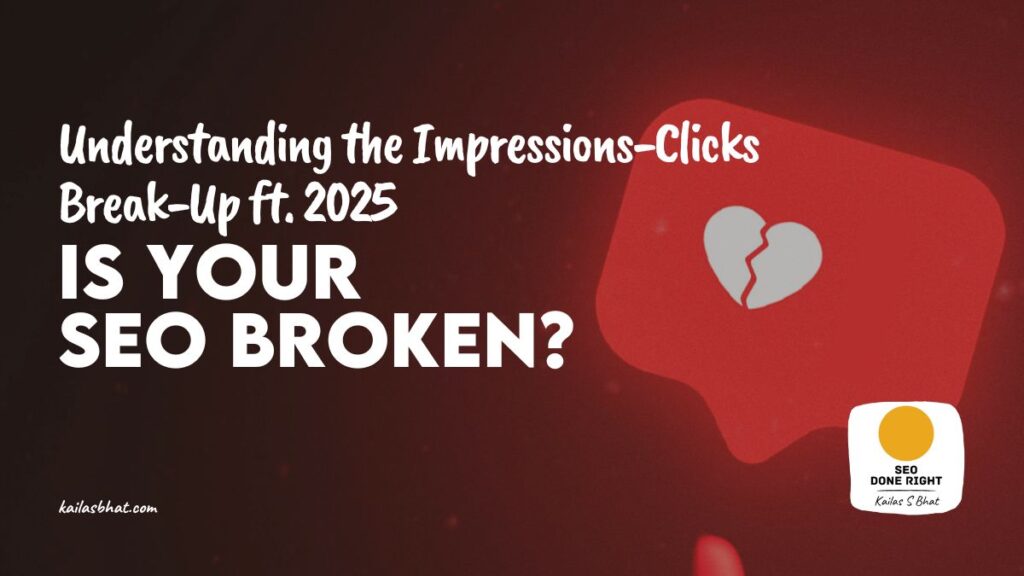
If you’ve been watching your Google Search Console (GSC) reports lately, you might have noticed something odd—impressions-clicks divide has widened. The impressions are shooting up, but clicks aren’t. It’s like you’re running a roadside stall with a giant neon sign, but fewer people are actually stopping by. Welcome to the era of “The Great Decoupling,” and trust me, it’s not just you.
The disparity in Impressions-Clicks is becoming a common topic among SEO specialists.
Table of Contents
A Story from the Trenches: Aqua Agro’s GSC Curveball
Understanding the Impressions-Clicks relationship is crucial for optimising your strategy. This trend indicates a shift in audience behaviour.
Take my client, Aqua Agro, for example. Over the past 16 months, their GSC data shows a textbook case of this new reality.
Monitoring this Impressions-Clicks can reveal insights into user engagement.
We see 2.54 million impressions, but only 52,800 clicks! That’s a click-through rate (CTR) of just over 2.1%. The graph here tells the story—impressions climbing, clicks fluctuating, and the gap between them widening. Ryan Law says this graph looks like an open-mouthed crocodile, and I totally agree.
This new approach to may redefine how we measure success.
The Impressions-Clicks dynamic affects all industries experiencing AI changes.
More discussion around Impressions-Clicks is vital for adjusting strategies. This correlation is more important than ever.
Shifts in Impressions-Clicks data reveal changing user demands. So, if you’re thinking, “Did I mess up my SEO?”—hold that thought. This isn’t about bad strategy or missed opportunities. It’s about how Google’s AI Overviews are rewriting the rules of the game.
This plays a critical role in SEO strategies.
What’s Actually Happening?
Here’s the deal: Google’s AI Overviews now give your content two shots at an impression for a single keyword—once as a classic blue link, and again as a citation in an AI Overview box. Sounds great, right? More visibility!
But here’s the catch: searchers are getting their answers right on the search results page. They see your brand, maybe even your content, but they don’t need to click through. The result? Impressions soar, but clicks stall or even drop. This is the “crocodile mouth” pattern you’re seeing in your GSC graphs—lines that used to move together now pulling apart.
Strategies focused on Impressions-Clicks can lead to better optimisation.
Impressions-Clicks divide is Industry-Wide, Not Just You
Recognising the importance of Impressions-Clicks is essential for growth.
This isn’t just an Aqua Agro problem or a “my niche is weird” thing. It’s everywhere. Industry data shows that since the rollout of AI Overviews, the correlation between impressions and clicks has flipped from positive to negative. In plain English: more eyeballs, fewer visitors.
When Ahrefs studied 300,000 keywords, they found that the presence of an AI Overview correlates with a 34.5% reduction in clickthrough rate. So, if your boss is breathing down your neck about falling clicks, show them the data—this is the new normal.
Why Are Impressions Up?
- Double Dipping: Your site can appear as both a blue link and an AI Overview citation for the same keyword.
- High-Ranking Content Gets Cited: Most AI Overview citations come from content already ranking in the top 12 organic spots.
Why Are Clicks Down?
- Zero-Click Searches: Users get their answers directly on Google, so they don’t need to visit your site.
- AI Overviews Satisfy Intent: The more comprehensive the AI Overview, the less reason for a user to click through.
What Does This Mean for SEO Done Right?
If you’ve read my thoughts on SEO Done Right, you know I’m all about safe, sustainable strategies. No shortcuts, no black-hat tricks.
The fundamentals for us haven’t changed. Keep the focus on:
- technical SEO
- on-page optimisation
- building real authority.
This is what folks at Google have to say about what you have to do to appear in AI features.
But the way we measure success needs to evolve. It’s time to stop obsessing over raw traffic numbers and shift our focus to:
- Brand Visibility: Continue tracking page impressions. If you are getting high impressions, it just means that people are seeing your brand. They may not be clicking your website from AI overviews, but hey, you are getting some eyes on the content you published. Remember to track impressions of brand and non-brand keywords.
- Conversion Quality: When users do click from AI search, they are far more likely to convert—sometimes up to 23x better than traditional search traffic. This shows that the users who click from AI overviews are like MQLs; nurture them, give them all they need to make a purchase, and voila, you have a conversion.
- Content Adaptation: Prioritise content that answers user intent directly and builds trust, so when users do need more, they come to you.
How to Track and Adapt
- Use tools like Ahrefs’ SERP features filter or GSC’s query reports (Web Search Type under performance report) to see where AI Overviews are impacting your keywords. We might not have a direct way to track clicks from the AI overview. So, keep an eye out for the clicks reports in Google Search Console.
Here is an excerpt from Google Search Central about measuring the performance of your site.
- Adjust your KPIs: set realistic growth targets that reflect the new landscape.
Final Thoughts
SEO as we have known it is changing, but then, it’s not as dire as some SEO ‘gurus’ have been preaching. Though the impressions-clicks divide has widened, the demand has not fallen; there are more potential customers out there than ever! Thanks to AI overviews, now there are more ways to reach them.
The real SEO experts are those who adapt to changes. They are easy to identify:
- They see impressions as an opportunity, not just a vanity metric
- They double down on building trust, authority, and memorable brand experiences.
So, next time you see that crocodile mouth in your GSC, remember: it’s not a sign you’re failing. This indicates a shift in the competitive landscape.
Learn, adapt, and succeed!

Pingback: SEO-Driven Revenue: The Hidden $7M CoinDCX Is Missing